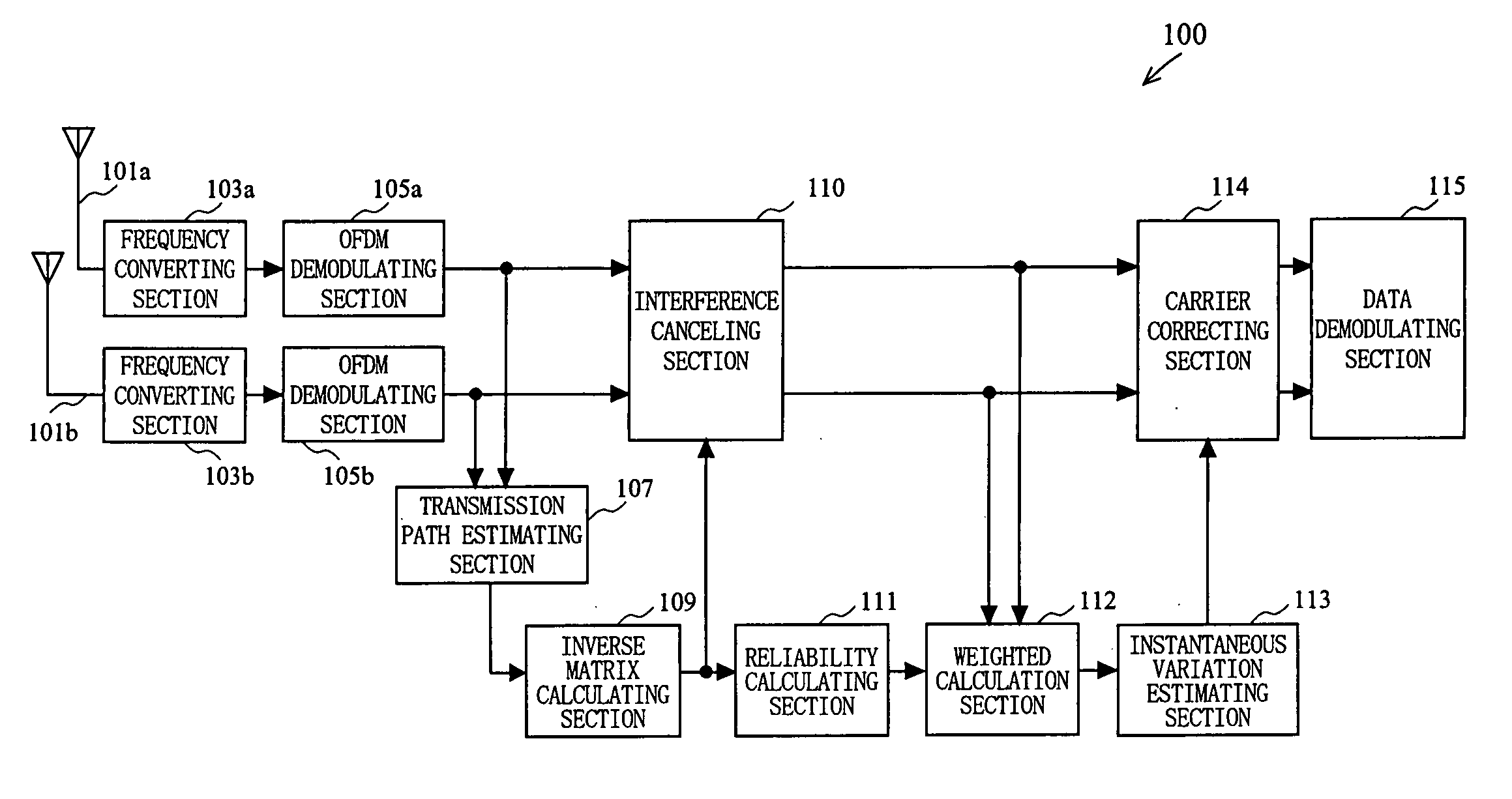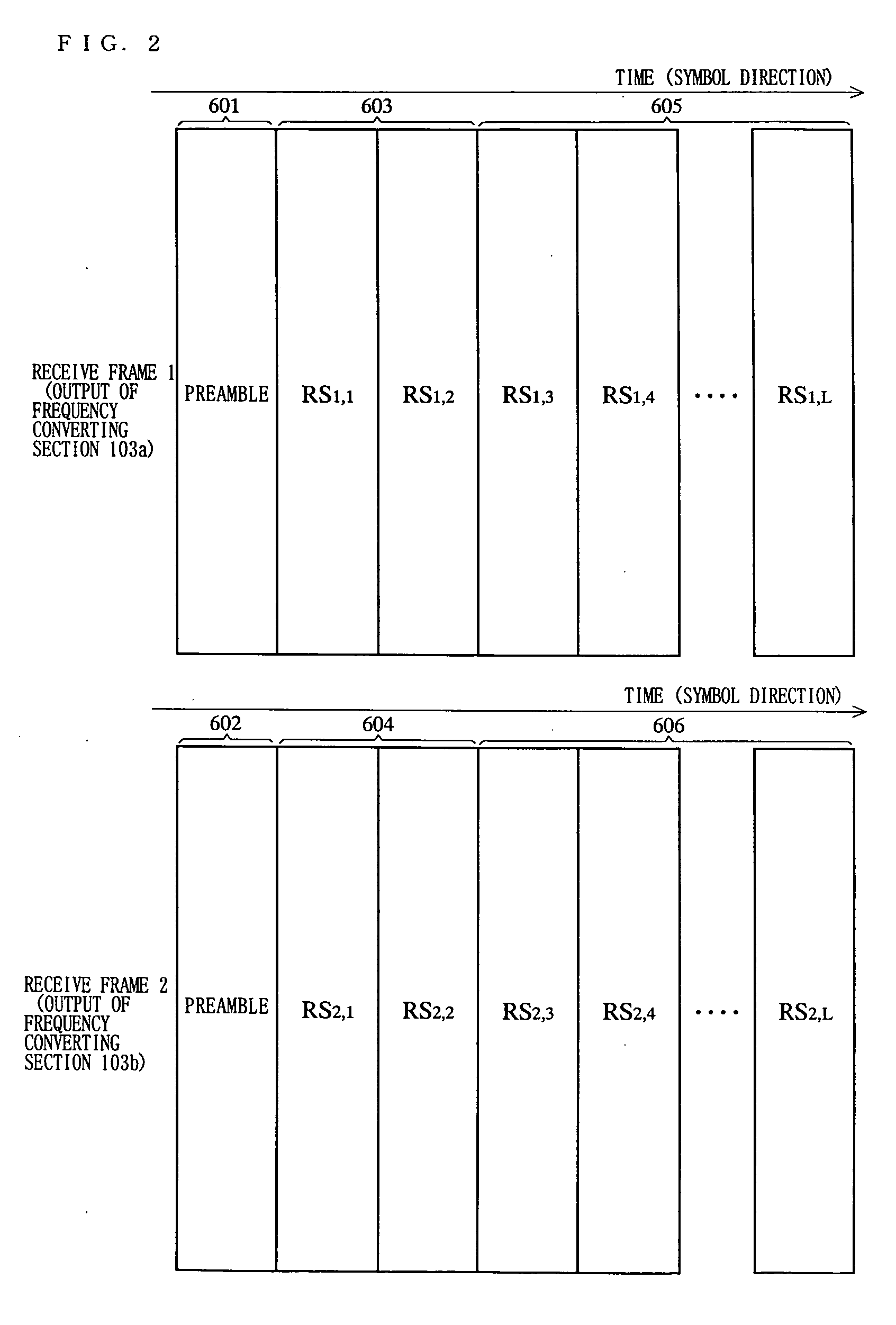OFDM receiving method of OFDM receiver
a receiver and receiving method technology, applied in the direction of orthogonal multiplex, multiplex communication, digital transmission, etc., can solve the problems of phase error in subcarrier signals, demodulation errors, and the possibility of significant error in estimation results, so as to accurately estimate transmission paths
- Summary
- Abstract
- Description
- Claims
- Application Information
AI Technical Summary
Benefits of technology
Problems solved by technology
Method used
Image
Examples
first embodiment
[0063]FIG. 1 is a block diagram showing a configuration of an OFDM receiver 100 according to a first embodiment of the present invention. Referring to FIG. 1, the OFDM receiver 100 of the first embodiment includes receiver antennas 101a and 101b, frequency converting sections 103a and 103b, OFDM demodulating sections 105a and 105b, a transmission path estimating section 107, an inverse matrix calculating section 109, an interference canceling section 110, a reliability calculating section 111, a weighted calculation section 112, an instantaneous variation estimating section 113, a carrier correcting section 114, and a data demodulating section 115.
[0064] The operation of various elements of the OFDM receiver 100 and the OFDM receiving method performed by the OFDM receiver 100 will now be described.
[0065] Signals transmitted from the OFDM transmitter (the transmit frame 1 and the transmit frame 2) are received at the receiver antennas 101a and 101b, and are inputted to the frequenc...
second embodiment
[0089]FIG. 12 is a block diagram showing a configuration of an OFDM receiver 120 according to a second embodiment of the present invention. Referring to FIG. 12, the OFDM receiver 120 of the second embodiment includes the receiver antennas 101a and 101b, the frequency converting sections 103a and 103b, the OFDM demodulating sections 105a and 105b, the transmission path estimating section 107, a propagation coefficient correcting section 128, the inverse matrix calculating section 109, the interference canceling section 110, the reliability calculating section 111, the weighted calculation section 112, a temporal variation estimating section 126, a frequency direction interpolation section 127, and the data demodulating section 115.
[0090] As shown in FIG. 12, the OFDM receiver 120 of the second embodiment includes the temporal variation estimating section 126, the frequency direction interpolation section 127 and the propagation coefficient correcting section 128, instead of the ins...
third embodiment
[0096]FIG. 15 is a block diagram showing a configuration of an OFDM receiver 130 according to a third embodiment of the present invention. Referring to FIG. 15, the OFDM receiver 130 of the third embodiment includes the receiver antennas 101a and 101b, the frequency converting sections 103a and 103b, the OFDM demodulating sections 105a and 105b, the transmission path estimating section 107, the propagation coefficient correcting section 128, the inverse matrix calculating section 109, the interference canceling section 110, the reliability calculating section 111, the weighted calculation section 112, the instantaneous variation estimating section 113, the carrier correcting section 114, the temporal variation estimating section 126, the frequency direction interpolation section 127, and the data demodulating section 115.
[0097] The OFDM receiver 130 of the third embodiment includes both the configuration for correcting the instantaneous variation component ea as described above in ...
PUM
 Login to View More
Login to View More Abstract
Description
Claims
Application Information
 Login to View More
Login to View More - R&D
- Intellectual Property
- Life Sciences
- Materials
- Tech Scout
- Unparalleled Data Quality
- Higher Quality Content
- 60% Fewer Hallucinations
Browse by: Latest US Patents, China's latest patents, Technical Efficacy Thesaurus, Application Domain, Technology Topic, Popular Technical Reports.
© 2025 PatSnap. All rights reserved.Legal|Privacy policy|Modern Slavery Act Transparency Statement|Sitemap|About US| Contact US: help@patsnap.com



